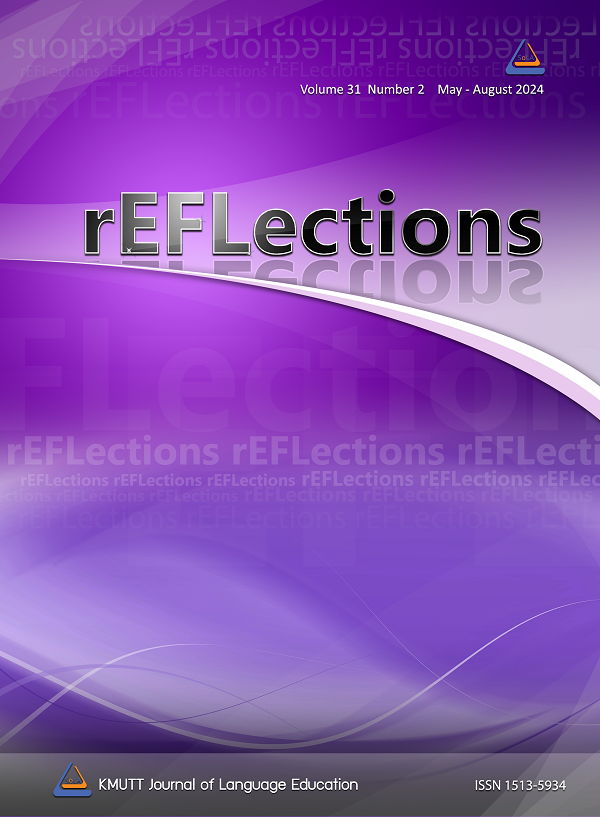Differentiating Learner’s English Proficiency in Oral Presentation Focusing on Textual Markers
Main Article Content
Abstract
Creating its own learner corpus, this research proposed to analyze and classify the transition markers used in solo presentation by 30 Thai engineering students based on Hyland (2019)’s Marker Categorization in Textual Metadiscourse. This research also aimed to identify and compare the quantities of individual transition markers among three groups of the selected 30 students (10 high, 10 mid, and 10 low users). The research employed both quantitative and qualitative method through SPSS, Transkriptor, and AntConc. The results showed that -and- was the top word utlized as a textual marker among all three groups while some other top transition markers ranked slightly differently among the groups. In addition to the search on the list of textual markers, the manual observation encountered other phrases acting as textual markers. The results indicated that users from average level can apply phrases as textual markers to communicate coherence instead of using traditional transition markers. Moreover, the “reminders”, the act of reminding the listeners of previous content, manifested as a possible indicator of advanced proficiency users as the weak users were found to not produce any of this category. Thus, learners may improve their English-speaking skills if they are guided through the process of developing coherence in context using various categories of textual markers.
Article Details

This work is licensed under a Creative Commons Attribution-NonCommercial-NoDerivatives 4.0 International License.
References
Arya, T. (2020). Exploring discourse marker use in Thai university students’ conversations. LEARN Journal: Language Education and Acquisition Research Network, 13(1), 247–267. https://so04.tci-thaijo.org/index.php/LEARN/article/view/237854
Bachman, L. F. (1990). Fundamental considerations in language testing. Oxford University Press.
Barker, F. (2010). How can corpora be used in language testing? In A. O'Keeffe & M. McCarthy (Eds.), The Routledge handbook of corpus linguistics. Routledge.
Bax, S. (2012). Text inspector [Online text analysis tool]. https://textinspector.com/
Bax, S., Nakatsuhara, F., & Waller, D. (2019). Researching L2 writers’ use of metadiscourse markers at intermediate and advanced levels. System, 83, 79–95. https://doi.org/10.1016/j.system.2019.02.010
Bui, H. P. (2022). Vietnamese EFL students’ use and misconceptions of cohesive devices in writing. SAGE Open, 12(3), Article 1126993. https://doi.org/10.1177/21582440221126993
Chotimongkol, A., Thatphithakkul, S., Chootrakool, P., Hansakunbuntheung C., & Wutiwiwatchai, C. (2011). The design and development of PELECAN: Pronunciation errors from learners of English corpus and annotation. International Conference on Speech Database and Assessments, 2011, 36–41. https://doi.org/10.1109/ICSDA.2011.6085976
Chung, E., Crosthwaite, P., & Lee, C. (2023). The use of metadiscourse by secondary-level Chinese learners of English in examination scripts: insights from a corpus-based study. International Review of Applied Linguistics in Language Teaching, 62(2), 977–1008. https://doi.org/10.1515/iral-2022-0155
Crosthwaite, P. R., & Raquel, M. (2019). Validating an L2 academic group oral assessment: Insights from a spoken learner corpus. Language Assessment Quarterly, 16(1), 39-63. https://doi.org/10.1080/15434303.2019.1572149
Flowerdew, L. (2012). Corpora and language education. Palgrave Macmillan.
Granger, S. (1998). The computer learner corpus: A testbed for electronic EFL tools. In J. A. Nerbonne (Ed.), Linguistic databases (pp. 175–188). CSLI Publications.
Granger, S., & Tribble, C. (2014). Learner corpus data in the foriegn language classroom: Form-focused instruction and data driven learning. In S. Granger & G. Leech (Eds.), Learner English on computer (pp. 199–209). Routledge.
Hyland, K. (2013). Metadiscourse. In K. Hyland (Ed.). Discourse studies reader: Essential excerpts (pp. 65–88). Bloomsbury Academic. http://dx.doi.org/10.5040/9781472541925.ch-004
Hyland, K. (2019). Metadiscourse: Exploring interaction in writing. Bloomsbury Academic.
Jones, C., & Waller, D. (2015). Corpus linguistics for grammar: A guide for research (1st ed.). Routledge. https://doi.org/10.4324/9781315713779
Khaghaninejad, M. S., Eslami, M., Yadollahi, S., & Jafari, S. M. (2021). A corpus based analysis of the application of “concluding transition signals” in academic texts. Cogent Arts & Humanities, 8(1), Article 1868223. https://doi.org/10.1080/23311983.2020.1868223
Mamuenvai, P., & Rhekhalilit, K. (2021). A corpus-based study of AND by Thai EFL learners. The Proceedings of the 59th Kasetsart University Annual Conference, 2021, 355–363.
McCarthy, M. (2010). Spoken fluency revisited. English Profile Journal, 1, Article e4. https://doi.org/10.1017/S2041536210000012
Meyer, C. F. (2002). English corpus linguistics: An introduction. Cambridge University Press.
Meyer, C. F. (2023). English corpus linguistics: An introduction (2nd ed.). Cambridge University Press. https://doi.org/10.1017/9781107298026
Pan, Z., & Aroonmanakun, W. (2022). A corpus-based study on the use of spoken discourse markers by Thai EFL learners. LEARN Journal: Language Education and Acquisition Research Network, 15(2), 187–213. https://so04.tci-thaijo.org/index.php/LEARN/article/view/259927
Thumawongsa, N. (2018). L1 transfer on Thai EFL learners’ utilization of prepositions: A corpus-based analysis. Journal of Community Development Research (Humanities and Social Sciences), 11(1), 35–47.
Walková, M. (2020). Transition markers in EAP textbooks. Journal of English for Academic Purposes, 46, Article 100874. https://doi.org/10.1016/j.jeap.2020.100874
Yang, W., & Sun, Y. (2012). The use of cohesive devices in argumentative writing by Chinese EFL learners at different proficiency levels. Linguistics and Education, 23(1), 31–48. https://doi.org/10.1016/j.linged.2011.09.004


